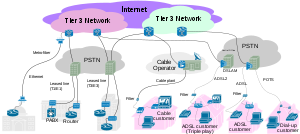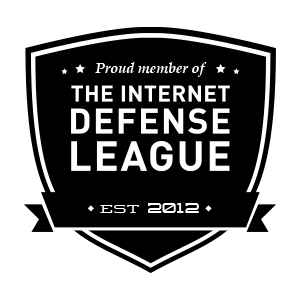Ladies and gentlemen, the days of unlimited broadband may be numbered in the United States, and we’re not talking wireless this time — AT&T says it will implement a 150GB monthly cap on landline DSL customers and a 250GB cap on subscribers to U-Verse high speed internet starting on May 2nd. AT&T will also charge overage fees of $10 for every additional 50GB of data, with two grace periods to start out — in other words, the third month you go over the cap is when you’ll get charged. DSLReports says it has confirmation from AT&T that these rates are legitimate, and that letters will go out to customers starting March 18th.
via AT&T will cap DSL and U-Verse internet, impose overage fees (update) — Engadget.
Do You Remember The Birth Of Cable TV?
Unless you date from the same era as I do, you probably don’t remember the birth of the Cable Television Industry.
Cable TV started out in communities with a problem. Their problem was a lack of usable signal. Usually the signal problem was caused by a natural feature between them and the broadcast station(s). They could solve their problem by building a receiving antenna in a location that could receive the signal (usually on a mountain top) and running a “cable” into town. But, it cost more than any one person would pay for “free” TV.
The abbreviation CATV is often used to mean “Cable TV”. It originally stood for Community Antenna Television, from cable television’s origins in 1948: in areas where over-the-air reception was limited by distance from transmitters or mountainous terrain, large “community antennas” were constructed, and cable was run from them to individual homes.
Wire the whole town and spread the cost across everyone in the community who wanted to watch TV and it could be “cheap enough”. But, it only worked if you had no competition to split the subscriber base.
When Cable began to emerge from the mountains in the 1960’s and early 1970’s guess who led the fight against them? It was the motion picture industry and the theater owners who held petition drives to keep Cable out of their communities. These people saw cable as a threat to their business model and the were right.
Most cities and towns regulated cable in the early days. Prices were negotiated. Competition was kept to a minimum or completely eliminated. Community channels were all the rage. But over time, the companies have merged into the few we see today. The main loss in all of this has been freedom of choice. You really can’t chose your channels, you get a choice of packages. Want to be able to watch in more than one room…You need to rent extra boxes.
Satellite TV
Satellite TV grew to fill the gap in the Broadcast TV and Cable map. It started out as a do-it-yourself answer to the lack of available signal in rural areas. Buy yourself a dish, a box of electronics, and pull in the behind the scenes news broadcasts and other raw network feeds. As time passed and more people bought systems, the broadcasts were encrypted and you had to buy decoder boxes to receive programming. Then the guys supplying the cable networks started renting out their decoder boxes and you could watch movies on your own system.
Eventually, the big satellites were replaced by lower powered lower orbit satellites. The big dishes that you sometimes still see behind farmhouses across the country were replaced by the smaller dishes attached to houses in both the rural and urban areas around the country. The programming went from whatever you could pull in to pretty much the same thing as the local cable company supplied.
Today both Cable and Satellite have become identical for all intents and purposes…They have the same content, the same business model, roughly equitable prices. They compete against each other.
Which brings us to:
The Internet
Originally, you had to have a telephone line to connect to the internet through a ISP, or Internet Service Provider. DSl and T1 lines were available, but most people couldn’t afford the cost so it was a dial up modem for most of us. Speeds were slow. Most of what you found was text. Very little in the way of graphics existed. This was the world of AOL, MSN, and a whole list of players I have now managed to forget all about. But the key was you had to already have a contract with a Telco.
Now…Telcos were a regulated monopoly. As long as you paid your bill, they didn’t care how long you stayed on your line…If they did they never said so. But, the powers that be deregulated the monopoly…And stipulated that they had to allow competitors to use their lines. It still looks like a monopoly, smells like a monopoly, it even quacks like a monopoly…But those very same powers that be no longer look real hard ah t the way they run their business.
In the process, the Telcos have branched out into the Cable business themselves. And the wireless business. And the Internet Provider Business. It wouldn’t be a problem at all except we are beginning to see a plethora of options open up on the Internet to provide you with entertainment. Netflix, Amazon, Hulu, YouTube and an untold number of others. And guess what…They charge you less than the cable guys or the satellite guys. They are beginning to eat into the profits of those older companies. So far it’s just the start of a trend. But I would imagine there are a number of households in the country like mine…three laptops, four TV’s, No Cable, No Satellite…Just a DSL line and a home network.
When the wife watches her soap episode each day, I’m surfing the internet or blogging, my daughter is either on Facebook or watching streaming video, my grandson will be watching “Thomas the Train” in the living room from streaming Netflix on the wireless TV while he plays with his wooden Thomas on the floor. Do we fall into what AT&T is calling the 2% of their subscribers who are abusing their network? I imagine we do. Do they offer us the option of getting their U-Verse system with the higher limit and the higher speeds? Not on your life…
So will I be paying a premium to continue using the Internet in the way we have become accustomed? I don’t know at this time. I’ll have to check my options…But I do have to say thanks a lot AT&T for shutting off another section of the Information Highway.
Related articles
- AT&T to kill unlimited data plans (cbsnews.com)
- AT&T caps monthly traffic for DSL subscribers (seattletimes.nwsource.com)
- AT&T Jumps Into The Metered Broadband Pool; 150 Gig Limit For DSL (techdirt.com)
- AT&T Puts Broadband Users on Monthly Allowance (wired.com)
- AT&T caps monthly traffic for DSL subscribers (sfgate.com)



